
views
Gathering Money and Documents
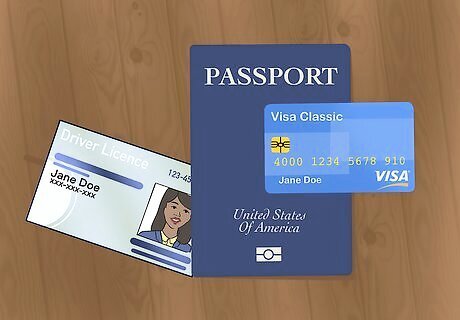
Bring a valid photo ID or passport. You aren't going anywhere without a valid ID. For international travel, bring your passport to flash at border control agents when you enter each country. A valid state ID, such as a driver's license, is enough for most domestic trips, but check the rules at your destination to make sure. Be aware that many countries require travelers to get a visa. The U.S., for instance, has tourist and immigration visas you have to apply for online. You can't get in without a valid visa from the government.

Carry your medical insurance card with you. Accidents happen, so you are better off being prepared than getting stuck somewhere during an emergency. Check with your regular insurance provider to see what is covered during your trip. Most places offer extra coverage to purchase in case you're traveling to a foreign country. Treatment can be expensive if you don't have the proper coverage. Many insurance policies reimburse you if you have to cancel your flight. You can't predict what will happen, but good coverage makes a trip cancellation much easier to deal with. You don't need travel insurance for short domestic trips. It's better for longer, costlier trips and ones outside of the country. Keep in mind that you are also required to get immunizations for some trips. Consider it to be part of the insurance process. Get them from a doctor 4 to 6 weeks before you travel.

Ask your doctor for documents about your medication and illnesses. These documents let people know what medical conditions you have and how to treat them. Call your doctor's office and ask them for an official note about what you're taking along with any prescriptions you need. Some countries are very strict about what you can take with you, and documentation helps you get through security much more easily. For instance, bring information about chronic conditions like allergies. This will also give you an opportunity to clear the trip with your doctor and get any necessary immunizations if you're going international. Countries like Japan, for instance restrict plenty of medical drugs. Some are allowed in with a doctor's note but others aren't. Clear up the confusion by looking up the travel regulations when you travel internationally.

Take a list of emergency contacts along with your phone. If you're like most travelers, you're going to have your phone with you when you fly. Store important contacts there, such as your closest friends and family members. Phones are not foolproof, so consider also bringing a printed copy of all the people and places you might need to contact. This includes any places you're staying at, places you have a reservation at, customer service numbers, and so on. Don't forget to stick your contact information on your luggage and electronics. Many bags have tags you can use, but you may also be able to get them at the airport. Another option is to buy ID tags or stickers before you travel. Include information like addresses if they're relevant. For example, customs officials could ask where you're staying when you enter a country. If you're going to another country, bring along the address and phone number for your country's embassy or consulate.

Carry some cash to get by when you arrive. Carrying a little bit of cash is always a good idea. Use it to buy food, book transportation, and otherwise get set up at your destination. The exact amount you need depends on where you're going, but focus at least on building a decent emergency fund like $100 USD. That way, you don't have to rely too much on dealing with banks or ATMs when you're at an unfamiliar place. You could use your bank or credit card for money when you're out of the country. Contact your bank first to inform them that you're traveling and find out if your plastic is good there. Be wary of high ATM fees when you travel. If you're leaving the country, consider going to a bank or exchange counter to get some of the local currency. You could also try getting traveler's checks to exchange for currency
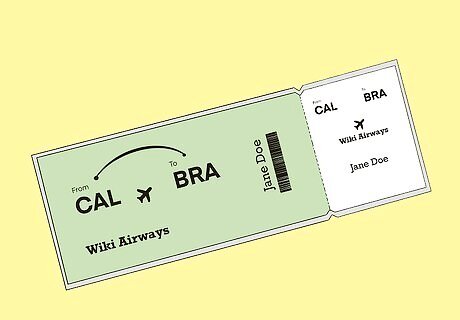
Bring your flight ticket so you can get your boarding pass. Double-check that you have your ticket booked and ready to go before heading off for your flight! Bring confirmation with you to the airline's check-in counter at the airport. There, you get a boarding pass with your flight information and seat number. You need that boarding pass to get on the plane, so have your ticket ready to go before leaving home. Getting a plane ticket is simple. All you have to do is book your flight online and watch for the confirmation letter in your email. Give your name and confirmation number at the airline service counter or kiosk to print your boarding pass. Many airlines have phone apps that create mobile boarding passes. You can also do an online check-in for your flight if you plan on printing out your pass or have it sent to your phone.
Packing Check-In Bags
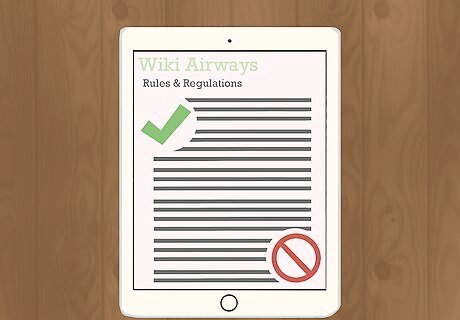
Look up the airline's bag and item regulations. There are a wide variety of airlines out there, and each one has different rules about what you can take with you. Traditionally, airlines let you take a carry-on bag onto the plane and check in a bag at the airport to put in the cargo hold. The size and weight rules for bags vary from airline to airline, so read up about them in advance to avoid unexpected fees. More and more airlines, including the budget ones, charge fees for every piece of luggage you check onto the plane. Unless you're packing super light, expect to contend with the fees when you check in at the airport. When you're reading up about your airline, pay particular attention to the size and weight limits of the bags you're allowed to bring. Going over these limits means additional fees. Airlines also charge extra for every additional bag you bring.
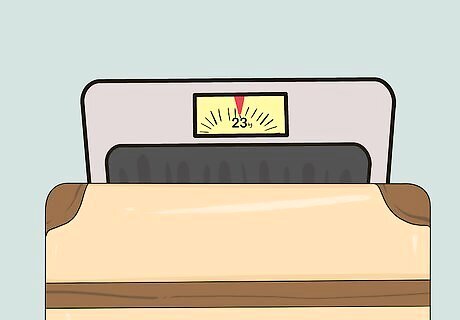
Weigh and size any luggage you're planning on bringing. The check-in system is a little confusing these days, so it pays to prepare for it in advance. Add up the length, width, and height measurements of your luggage to figure out its size. Then, weigh the packed bag on a bathroom scale to figure out its total weight. Every airline has different rules about what bags they will carry without charging you extra fees. On average, your bag needs to be no more than 62 in (160 cm) in size, or 27 × 21 × 14 in (69 × 53 × 36 cm). The maximum weight for the average checked bag is 50 lb (23 kg). Try to keep your bag under this limit to avoid fees. If you have to bring a lot of stuff, consider packing a second bag since it is often cheaper than bringing a single, heavy bag.

Pair clothes into outfits for all the days you will be away. Plan on bringing a change of clothing for each day of your trip. That includes pants, shirts, socks, and underwear. How you dress depends on what kind of weather you are expecting at your destination. Match your outfits before you pack so you aren't left scrambling to look your best when you're on the road. For example, if you plan on taking an 11-day vacation, pack enough clothing for 11 outfits. Consider slipping a set into your carry-on bag so you have it in case anything happens to your luggage. Clothing easily is the biggest obstacle to packing since you need so much of it. Find ways to avoid taking a lot, such as by packing lightly and making use of laundry services at your destination.
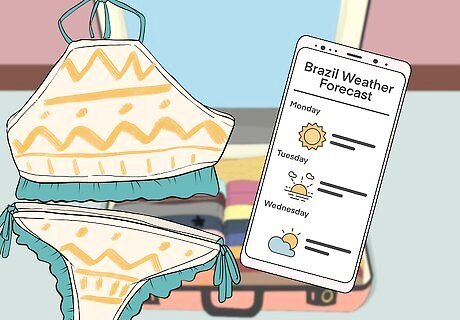
Bring heavy clothes and swimsuits if you need them. Fill out the rest of your wardrobe with clothes matched to the conditions at your destination. If you're planning on swimming, bring a couple of bathing suits along. If you expect to face cold weather, choose warm outfits and pack gloves, hats, and other items. Check out the forecast for your destination and pack accordingly. Think about carrying an extra pair of shoes as well if you have space. You can wear your walking shoes, but you might need something comfortable or water-resistant like flip-flops. Wear a coat or jacket onto the plane so you don't have to make room for it in your luggage. It doesn't count against your carry-on limit.
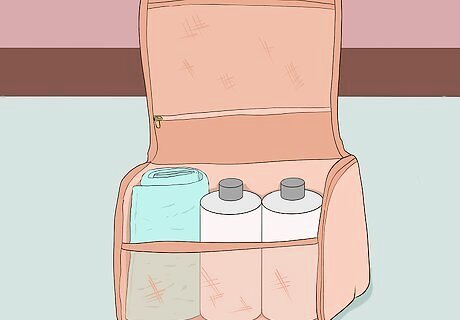
Pack hygiene supplies you need for your trip. Shampoo, deodorant, a toothbrush, and toothpaste are a few examples of supplies any traveler needs. Buy travel-sized containers of everything you need. Even though liquids are restricted on planes these days, you are allowed to bring small containers with you. Stow them all inside a 1 US quart (950 mL) plastic bag so they aren't rattling around inside your luggage. Consider adding important supplies to your carry-on. For example, deodorant and toothpaste are handy to have available on a lengthy flight. Any bottle over 3.4 fluid ounces (100 mL) in size has to be in your checked luggage. Most supplies are fine in a checked bag, but go for a smaller bottle if you wish to carry it with you on the plane. If you're going the ultralight route, eliminate anything you expect to buy when you arrive at your destination.
Assembling Carry-On Bags
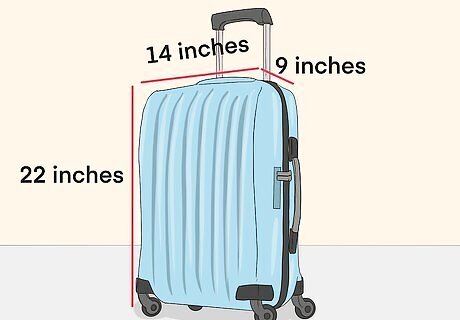
Get a bag that is an approved size by the airline. Like with checked bags, airlines have strict limits on what you can carry onto the plane. Wheeled carry-on bags, duffel bags, backpacks, and purses are a few common options to bring onto a plane. The size limit varies a little bit between airlines, but there isn't a weight limit to worry about. Use this bag to store important items like your travel documents, electronics, medicine, and a change of clothes. The average maximum dimensions for a carry-on bag is 22 × 14 × 9 in (56 × 36 × 23 cm). Keep in mind that if your carry-on bag is too big, you will be asked to check it in at the airline's counter before you're allowed through security. That means you have to pay any fees that come along with checked bags, too.
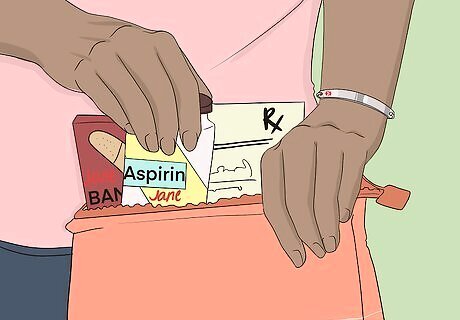
Pack a supply of medications you need for your trip. Band-aids and aspirin are great to have around, but it's prescription medication you have to plan for. Keep in mind what you need and bring enough of it. Talk to your doctor about any special preparations you need to make. Also, bring a doctor's note and instructions for using your medication. Keep your medication in its original container labeled with your name and the dosage. Don't leave medication loose in your bag or a pill organizer since that makes it more difficult for security to identify what you're carrying. Consider bringing along information about serious conditions like allergies. You could get a medical alert bracelet to wear. That way, you can get better treatment in case something goes wrong.
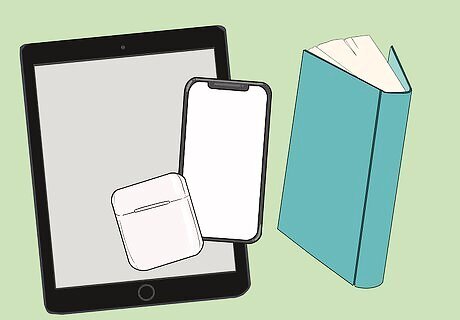
Bring plenty of entertainment to keep you busy during the flight. Entertainment is especially useful for longer flights. Many airlines play movies on a flight, so consider packing a pair of headphones to tune in. Bring along alternatives like books, games, a tablet, or a laptop. Remember to bring charging cables for your electronics and keep them safely stowed away inside your carry-on. The best entertainment device to bring is a tablet since you can load all sorts of apps on it. Load it up with plenty of books, movies, music, and games. It takes up way less space than alternative forms of entertainment. Try to plan out how you intend on filling the time. Set aside a couple of hours to watch a movie, for instance. If you're on a long trip, estimate the remaining flight time you have left to fill and pack accordingly.

Take some snacks in case you get hungry during your trip. No one wants to survive off of airline peanuts, so pack solid foods like granola bars. Bring things that won't spoil and won't cause a mess when you try to eat them. Many airlines these days don't serve much in the way of complimentary food, so have some snacks in reserve to stay comfortable during the flight. On the plus side, it will also help you avoid expensive airport food! Check the airline and travel security rules to plan what you are bringing. You will be surprised at what you're allowed to bring. They let you bring just about anything, but solid, lightweight snacks like fruit, chips, and cereal are best. You can't really bring drinks past security. What you can do, however, is bring an empty bottle with you and fill it up before you get onto the plane. Alternatively, buy a drink at the airport after clearing security.
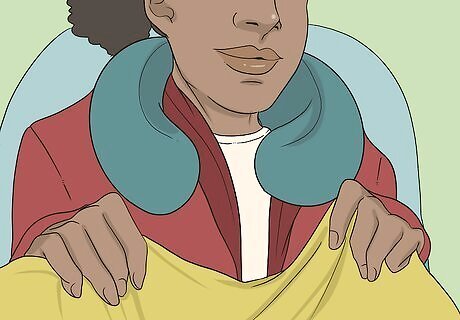
Bring a blanket and travel pillow if you think you need it on the plane. Most airlines no longer give out pillows and blankets to use on the plane. Plane compartments get a little cold, so dress warmly or bring a small blanket. Get a travel pillow to stay comfortable when you're stuck in those rough seats for a while, particularly for overnight trips. Your comfort is worth the extra packing. Airlines generally let you take a personal item onto the plane along with your carry-on. Blankets and pillows are great choices if you can't fit them into your bag. Noise-cancelling headphones or earplugs are also good to bring if you plan on sleeping on the plane, though they're also good for some peace and quiet while you're awake.
Heading to the Airport
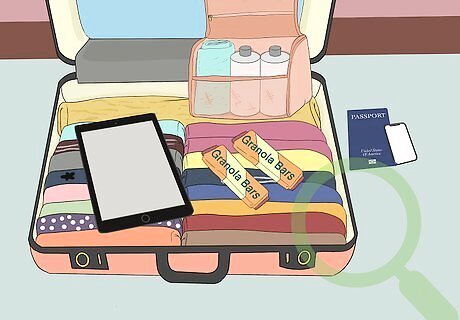
Do a quick inspection of your bags to make sure you have everything you need. Every traveler is familiar with the, “I forgot this very important item at home!” dilemma. Look over both your luggage and your carry-on, making sure everything is in its place. Also, look for anything that might cause you trouble as you attempt to reach your flight. To avoid leaving important things at home, make a list of everything you need. Pack in advance so you don't end up hoping you fit everything in at the last minute. Look up a list of what is illegal to bring on planes. This will make the check-in process much easier. Security can force you to throw away things like big bottles of liquids, so make sure those items are in your luggage if you intend on bringing them.
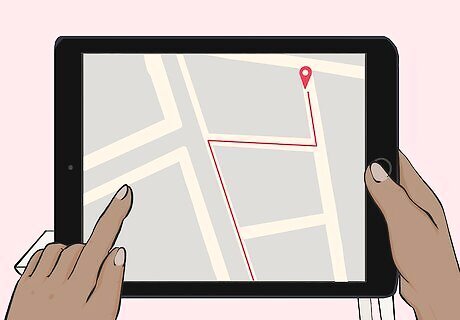
Find a way to get to and from the airport. The easiest way to do this is to have someone drop you off and then pick you up at your destination. That way, you can throw your luggage in and be on your way. Arrange for your ride in advance. Plan out your route so you know how long it takes to get there. If you're a driver, airports have places where you can leave your car. It gets pricey, so read up about the fees first. Public transportation is an option sometimes if you don't mind hauling your luggage yourself. Otherwise, call a driving service in advance so you have plenty of time to get to the airport.
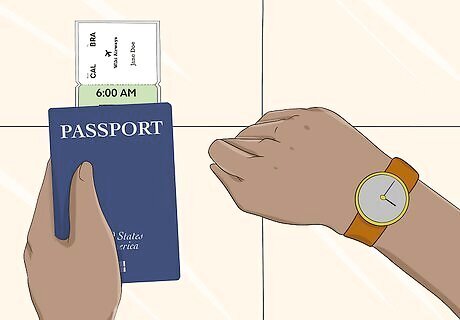
Arrive at the airport at least 2 hours in advance. This is the timeframe recommended by airlines and airport security. It gives you plenty of time to get your boarding pass, check your bags, and pass through security. Many airlines cut off check-in 30 to 60 minutes ahead of the departure time for security reasons, so don't risk being late! If you check in and print your boarding pass out in advance, you may be able to save some time. Keep in mind that you can't control the wait to get through airport security. Give yourself plenty of time to get through security, especially during busy travel periods like holidays, so you don't miss your flight.

Head through security after checking into your flight. Stop at the your airline's check-in counter at the departure gate at the airport. Afterward, walk toward the nearest security gate leading deeper into the airport. The lines can get pretty lengthy on busy traveling days, but that is why you got to the airport ahead of time. When you pass through security, check the departure boards to find out what gate your flight is at and head there to board when the plane lands. Getting through the airport is relatively simple as long as you took care to pack your bags. The guards will check your carry-on and give you a quick pat-down. Security checkpoints are always in the same area as the airline check-in counters in the opposite direction of the entrance doors. Also, look for screens and signs posted on the walls with information about where your plane is. This information may also be printed on your boarding pass. If you check in online or through an airline app, you do not need to visit the airline counter. Instead, head toward security. Your boarding pass is in the app or an email you can print out at home.




















Comments
0 comment